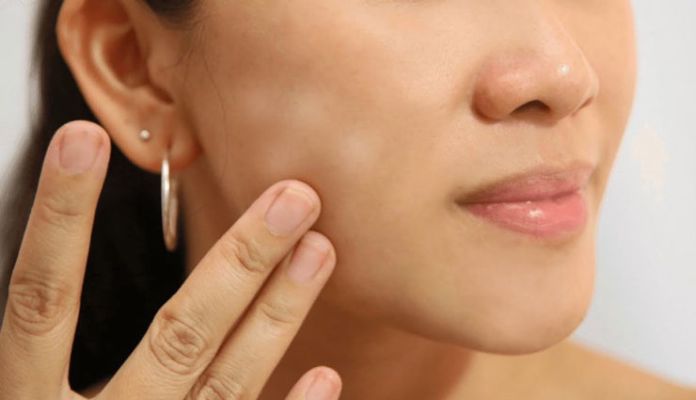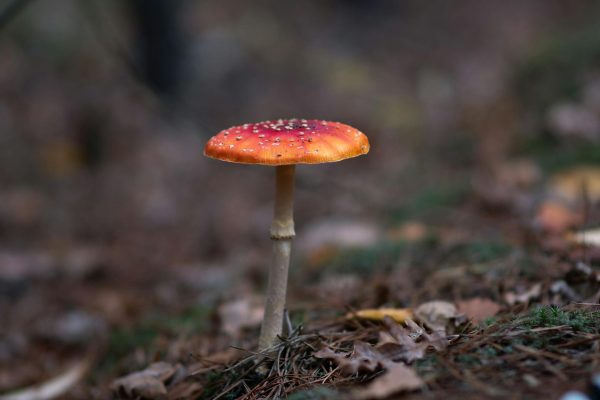White spots on the skin can be impacted by many causes, including common mycosis and white freckles, as well as skin conditions such as eczema, hypopigmentation, and vitiligo.
When a white spot develops on your skin, make a note of its size, location, when it emerged, and whether you have any other effects, such as scratching, dry skin, and peeling. Then, contact a doctor to determine the cause and begin the most effective care.
Start by looking for some of the most usual skin conditions that cause white spots on the skin to become familiar with their indications.
It is important to remember that you can never focus solely on self-diagnosis; accurate diagnosis and recovery recommendations include visiting the doctor.
6 Most common causes of white spots on skin
1. Tinea Versicolor

Tinea Versicolor is a disease that develops when pityrosporum ovale, a normal yeast present on the skin, expands uncontrollably and starts to alter the skin colour. Spots of skin can become lighter or darker as a result of this.
Tinea versicolor can be affected by a number of causes, including heavy sweating, hot temperatures, dry skin, a compromised immune system, hormonal variations, and itchy skin. It is most common in teenagers and youngsters, but it can also occur in adults as they experience warm and moist climates.
Over-the-counter antifungal treatments are often used to treat Tinea versicolor, which effectively removes the discoloured stains or spots. If these drugs do not operate, you can call the doctor and have further testing performed to ensure that you have tinea versicolor.
To handle it, a doctor can prescribe a medicinal cream or prescription tablets. Many patients are able to completely remove the infection, but the skin can stay discoloured for some time following treatment, lasting from weeks to months. The disease may often resurface, particularly if the patient returns to a hot climate or begins taking hormonal medicine.
Risk elements
Tinea versicolor can be caused by a number of causes, including:
- a relatively weak immune system
- as a result of excessive sweating
- humid conditions
- oily skin
Treatment
Based on the nature of the infection, a number of therapies are available for tinea versicolor. OTC choices include medication-strength cleaning products or antifungal skincare products, soaps, ointments, and shampoos that contain:
- Clotrimazole
- Terbinafine
- miconazole
- selenium sulfide
A doctor may administer a prescription-strength medicinal product shampoo or tablets if the infection is severe.
Preventative measures
Though tinea versicolor is curable, skin discolouration can last for a long time. To avoid recurrent infections, take the following precautions:
- During hot or humid weather, use prescribed medication cleansers to prevent overheating.
- Minimize or restrict sun exposure.
- minimize excessive sweating
2. Sunspots
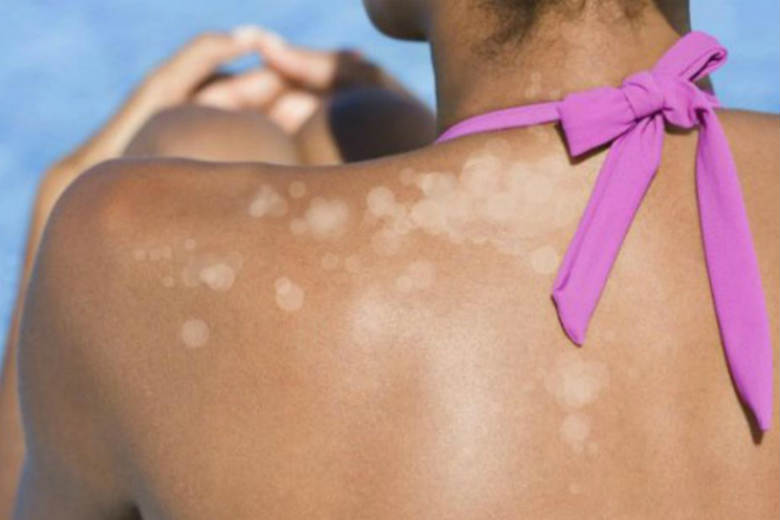
Sunspots are white patches on the skin caused by a loss of pigment.
These spots, which are 1–3 mm in size and occur first on the thighs before spreading to the head, upper back, and face, usually cause no symptoms.
Researchers remain baffled as to what causes sunspots. A deficiency of a skin pigment termed melanin may be one of the causes. Sunspots tend to run in families as well. They are most likely to manifest after the age of 40.
They are, however, innocuous, and handling them is merely cosmetic.
Although excessive sun exposure without sunscreen may increase the risk of developing cancer, sunspots do not indicate the growth of cancer cells.
Risk elements
Sunspots are entirely harmless and can have no effect on your health. However, if you note any of the following alterations, you can see a doctor:
- Spots get darker
- Spots get darker
- Itchy or sore spots develop
Preventative measures
The following are the most effective methods to avoid sunspots:
- avoid overexposure of the skin
- apply sunscreen
- Wear skin-covering clothes on a daily basis.
3. Pityriasis alba
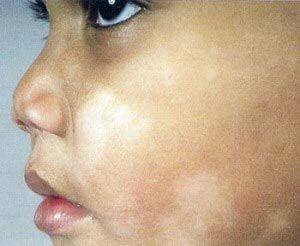
It is a skin disease that most often affects children and young people, causing light pink or red, flaky spots on the skin. When these spots fade, the skin becomes discoloured, with shiny, light patches replacing them.
Lesions may be circular, oval, or triangular in shape, and several patches can appear simultaneously, especially on the face and arms. Pityriasis alba is thought to be related to eczema, and because of that, a hyperactive immune response is a possible cause.
Spots will clear up in a matter of months or, in some cases, over many years. Pityriasis alba does not need surgery because the spots fade with time, with most cases disappearing by adulthood.
On the other hand, a doctor will often administer a steroid or non-steroid product to relieve the dryness or scratching. In some instances, the patches can reappear in the future and necessitate further care.
Treatment
Pityriasis alba is not infectious and always resolves on its own. To relieve complications, a doctor may also administer topical medications or non-steroidal creams.
Preventative measures
While there is no way to avoid Pityriasis alba, you can reduce its effects by following a skincare regimen that includes:
- bathing or showering in warm or lukewarm water rather than boiling water
- Avoiding scented cosmetics
- shielding yourself from sun rays
- using cream-based moisturizers during the day.
4. Vitiligo
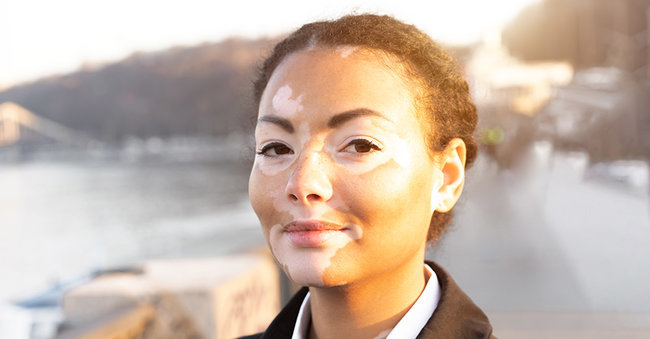
It is a type of skin discolouration. It usually happens when melanocyte cells cease to produce melanin because they either die or stop functioning. The causes are unknown, but it is assumed to be an autoimmune disorder. It can manifest itself at any age and on any area of the body.
The white spots may occur anywhere on the body at times, but they may also stay the same size. Vitiligo frequently begins as a small, fair-skinned spot on the skin and progresses to a bigger patch over time.
Vitiligo is usually not infectious and is not contagious, although its aesthetic presence can cause mental and psychological pain in those who have it.
Several therapies, including corticosteroid skincare products, depigmentation therapies, and UVA and UVB phototherapy, can further improve the effect of vitiligo. Any of these therapies have side effects, so it is best to consult with a doctor before proceeding.
Risk elements
The exact cause of vitiligo is undetermined, but doctors suspect it is an autoimmune disease caused by the body damaging its own cells. Many that have such autoimmune disorders are even more likely to experience vitiligo.
Vitiligo will develop as a result of:
- catching a bad sunburn or cut
- being under a lot of pressures
Treatment
There is no solution for vitiligo, and the best treatment is to do none at all! Winnie Harlow, the supermodel, demonstrates that white spots are still in.
If you like, you can even watch beauty tips for vitiligo concealment.
Some therapies to consider with your doctor include:
- Medicated creams are drugs that affect the immune system.
- Surgical treatments
- light therapy
- Supplements such as folic acid, vitamin C, and vitamin B-12
5. Eczema
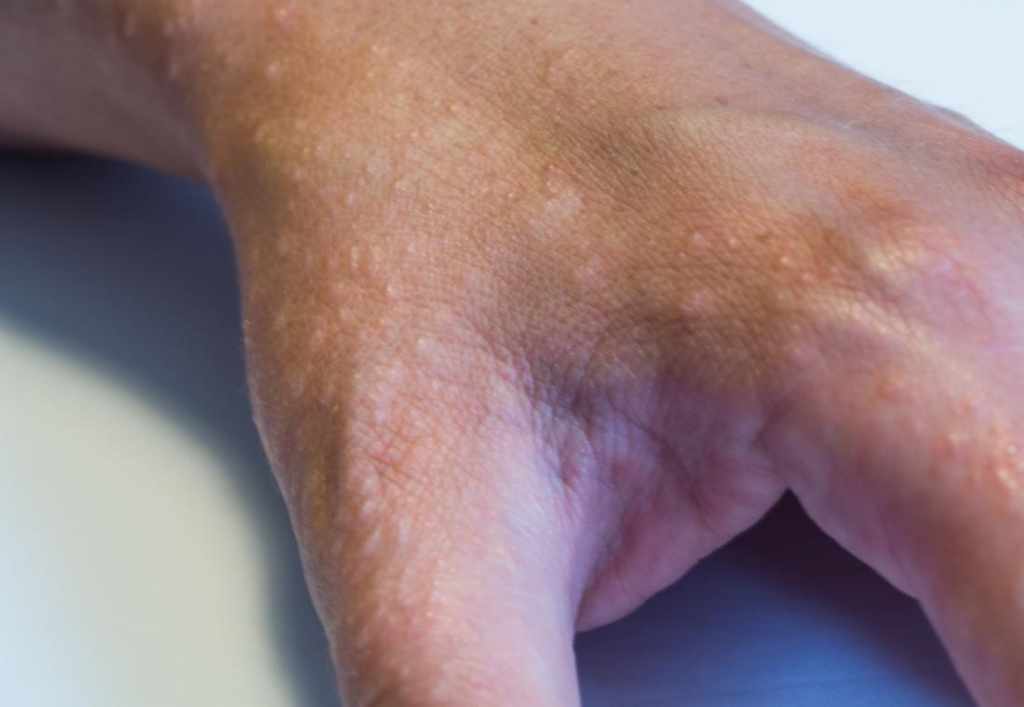
Eczema (atopic dermatitis) is marked by swollen, itchy rashes and have raised spots. White spots may appear on these rashes.
The below are some of the most often affected areas:
- face
- scalp
- palms
- feet
- knees
- eyelashes
- ankles
- backs of knees
Almost often, the rash itches, often painfully and particularly at night. The rash, if rubbed, will cause open, leaky sores.
Eczema-affected areas of the body can become thicker, dry, and flaky over time.
Eczema skin problems will flare up and fade without any discernible pattern. Symptoms can also go unnoticed for years at a time.
It’s possible that it’ll be a chronic disease. It’s also normal in people who suffer from allergies like hay fever.
Risk elements
The following are the primary risk factors for eczema:
- There is a family history of eczema
- Asthma and allergies
- heavy fever
Treatment
- Heavy creams or ointments antihistamines.
- avoiding harmful soaps and detergents
- take a warm or lukewarm shower or bath instead of hot ones allowing stress-reduction
- lifestyle changes
- light therapy
6. Lichen sclerosis
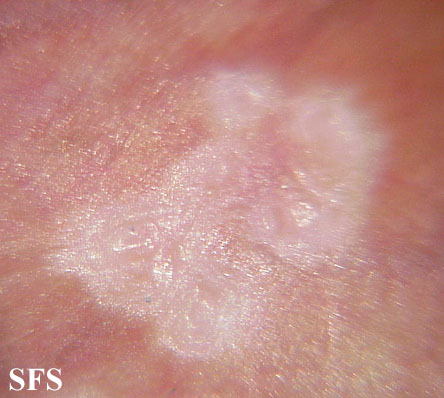
It is a long-term disease that generally affects the genital tissue. Lichen sclerosis is most frequent in women who have been through menstruation, but it can also affect men and children.
Smooth white spots on the skin that attach together and become cracked or swollen, itchy skin, fragile, wrinkly or thickened skin, sores, and discomfort when having intercourse or going to the bathroom are typical signs.
Although the exact cause of lichen sclerosis is unclear, hormonal imbalances and an overactive immune response are contributing factors. It is not a communicable disease and cannot be passed on to others by sexual contact.
Risk elements
Although lichen sclerosis may affect anybody at any age, the following people are at a higher risk:
- postmenopausal women
- females in their adolescence
- males that have not been circumcised
Treatment
- Topical medicines or creams
- Treatments of ultraviolet radiation
- removing the foreskin
When do you see a doctor?
White spots on the skin are ordinarily harmless and should not be considered a cause for alarm. In most cases, they can go away on their own or be controlled with basic at-home remedies or a doctor’s medication.
It’s still a smart thing to see the dermatologist find out any underlying issues.
Please contact your doctor right away if you have any of the following symptoms:
- alterations in your locations (size, shape, colour)
- Spots become irritating, and the itch caused by them becomes extreme or debilitating.

